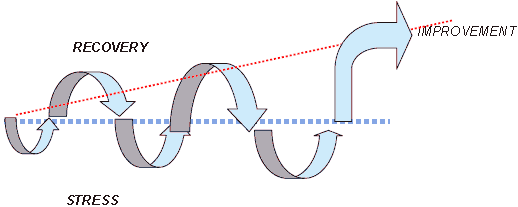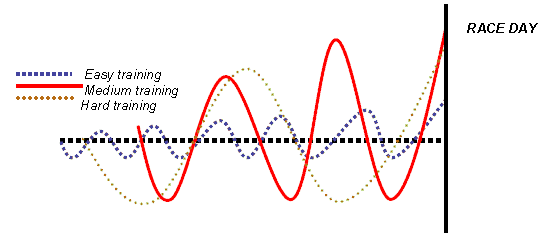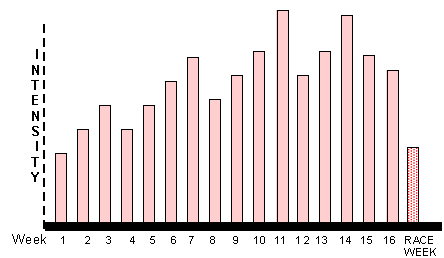

When Not to Train Hard
Introduction
Lance Smith explains why "rest" is essential to performance improvement and how to plan it into your training.
Training does not improve fitness—true or false? Consider the logical extension of the statement—the more you train, the less fit you become. We must remember that it is not the training that improves fitness; the recovery after exercise that allows adaptation and development.
Resting is training
Training is physical stress to the body. Keep stressing the body, and the athlete's performance will go backwards. If you stress the body and let it recover, then performance improves. When you apply stress and recover, the body bounces back slightly higher than before
It is straightforward, yet many athletes ignore it. Without rest, there is no improvement; if you keep stressing the body without recovery, this will lead to overtraining.
The relationship between stress, recovery, and improvement is illustrated in diagram 1.
Diagram 1

Note: As fitness improves, the training load (stress) also increases, so as fitness improves, training intensity and/or volume increase.
Important for master (Vet) athletes
As we age, we take longer to recover from hard training sessions. For many, the answer is to reduce stress, i.e., hard training sessions. Rather than reducing the stress, we would be better off increasing the recoveries. Endurance deteriorates more slower than speed, flexibility, and anaerobic tolerance as we age.
Vets often work on their strengths (endurance) and ignore their weaknesses. It is better to continue with the speed and speed endurance work, hills, time trials, and tempo runs, and allow more rest days or easy runs. It will likely reduce the overall training, but quality should be maintained.
Notably, the training effect of hard anaerobic sessions, while having more stress and a higher bounce back, does not last as long as aerobic sessions. These have a more extended benefit, less stress, and a slower recovery.
However, the real key to training is to time all the stresses and recoveries so all improvements coincide at the right time, allowing you to peak for the critical race or races, as in diagram 2.
Diagram 2

Hard/Easy
Resting with easy sessions is part of the training. This, of course, includes active rest, and both should be incorporated into the planning. This is the basis of hard/easy training - hard training sessions followed by easy sessions, hard days by easy days, hard weeks by easy weeks (or microcycles), hard competition cycles by easy periods, even easy years following hard years, all giving the body a chance to recover and improve.
A hard/easy pattern means cutting back periodically to allow the body to consolidate gains made. Such easy periods can be timed to coincide with races during the cross-country season or lead-up races in the track season.
Diagram 3 shows a week-by-week plan for a 16-week (mesocycle) build-up for an important race, say a championship event. Every fourth week is an easy week.
Intensity signifies how hard the week is, but it is not necessarily the total distance run. For instance, a week with two anaerobic sessions might be challenging even though the kilometres for the week may be down. This particular training pattern has two weeks of reduced intensity leading into the race. These two weeks would feature increased quality and reduced volume (distance run). There would also be hard/easy days within each week, even hard/easy sessions, should the athlete be training twice daily.
Diagram 3

Hard/easy can also be applied to years. A high level of competition may need to be followed by an easier season where training and competition goals are reduced.
The Taper
Most training programs ease up as important races are approached. This is peaking or tapering. You cannot expect an athlete to train hard and race simultaneously. Before a competition, training volume goes down, although the intensity stays where it is or increases.
Tapering boosts glycogen (fuel) stores, reduces muscle damage, increases muscle power and strength, and improves the neural system, which leads to better coordination, technique, and running efficiency.
A high volume, frequency, and intensity workload leads to short-term fatigue, which, of course, reduces performance. When the training load is reduced, fatigue declines, but fitness is maintained for a period.
A taper also has psychological benefits: as the athlete freshens up, confidence improves, eagerly looking forward to the race. "I am ready to race, I want to race, let me get into it" is often the reaction.
The key is balancing optimum competitive performance (physical and mental). That, of course, depends on the event and the athlete. (Note that a longer taper is important for masters, and older athletes need it.)
Do not worry about athletes losing fitness in a taper. Reducing the training volume for 7 to 10 days (up to 28 days for a marathon) before the big event achieves all the benefits above. Yet tests have shown that when intensity is maintained or increased and volume reduced by 66%, VO2 max is maintained for 15 weeks. Other tests showed that increasing training intensity gains resulted in more significant improvements than training at the same intensity through the taper.
However, you must ensure the intensity is not overdone, particularly in the last few days before racing. Too much, and the athlete is left with severe acidosis, a shattered neural system, and possibly a fatigued muscular system. Here is what the noted New Zealand distance coach Chris Pilone had to say on over-cooking the taper (he was referring to a 1500m runner, but the principles apply to all)
"Race pace work all that is needed to prime the lactate system close to a race. Any faster than the pace required risks excess acidosis, and rather than the athlete being able to absorb the work, recover, and come back more strongly equipped to race, he will struggle to recover, let alone progress. As Pat Clohessy used to say, it's nice to slightly underdo the fast training and leave a bit of adrenaline to complete the work on race day".
The body must only re-learn how to handle lactate at the liberation rate during the race. With race-pace work, plenty of recoveries are required because we teach the body to relax at race speed and become chemically and mechanically efficient at those speeds. If the muscles are in acidosis from working at a very high rate, they will reach a point where the nervous system will fail to respond efficiently. It makes much more sense to give the athlete a realistic race-paced session that he can absorb efficiently and recover from quickly.
Applying the hard/easy principles will also have to taper in regular training.
Tapering Summary:
- Maintain intensity and duration - reduce frequency by 66% = VO2 max for 15 weeks.
- Maintain intensity and frequency - reduce the duration by 66% = VO2 max for 15 weeks.
- Maintain frequency and duration - reduce intensity by 66% = VO2 max goes down after 5 weeks.
- Maintain frequency and duration - reduce intensity by 33% = VO2 max goes down after 10 weeks.
So, from the above summary, reducing intensity reduces the effectiveness of the taper.
Page Reference
If you quote information from this page in your work, then the reference for this page is:
- SMITH, L. (2006) When Not to Train Hard [WWW] Available from: https://www.brianmac.co.uk/articles/article020.htm [Accessed
About the Author
Lance Smith is a practicing coach with Athletics Southland in New Zealand. He has coaching qualifications in sprints, track endurance, road and cross country, steeplechase, and high jump, and has coached athletes to national championship medals in all the above events. He is also an active "master" athlete who participates in harriers, track events, and jumps. He lives in Invercargill, New Zealand. This article has been produced here with his kind permission.